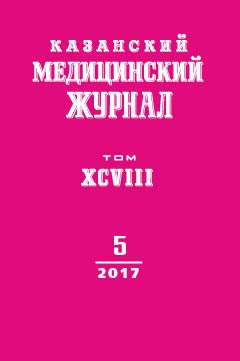Change in affordability of medications in Kazan in 2011 and 2015 as a reflection of state initiatives to regulate drug prices
- Authors: Razzakova C.M1, Ziganshina LE1
-
Affiliations:
- Kazan (Volga region) Federal University, Institute of Fundamental Medicine and Biology
- Issue: Vol 98, No 5 (2017)
- Pages: 822-826
- Section: Social hygiene and healthcare management
- URL: https://kazanmedjournal.ru/kazanmedj/article/view/7042
- DOI: https://doi.org/10.17750/KMJ2017-822
- ID: 7042
Cite item
Full Text
Abstract
Aim. Performing comparative analysis of drug prices in 2011 and 2015 in Kazan to assess the effectiveness of state initiatives to ensure the affordability of medicines.
Methods. The collection and processing of data was performed according to methodology developed by Health Action International and World Health Organization (WHO/HAI). We studied the availability and prices of 30 medicines in public and private pharmacies in Kazan in 2011 and 2015 and analyzed the procurement prices of the same medicines in inpatient hospitals. Recording and analysis were performed using standardized MS Excel WHO/HAI Workbook. Medicine prices were compared with international reference prices and were expressed as median price ratio.
Results. The analysis showed a decrease in medicine prices in 2015 compared to 2011. In public and private sectors median price ratio of the originator brands reduced by about 3 times, and of the lowest price generics reduced by 1.5 times. A decrease in procurement prices by more than 2 times for generics and more than 6 times for the original brands was also revealed in 2015 in comparison with 2011.
Conclusion. State initiatives to regulate drug prices contributed to the price reduction by 1.5-3 times in 2015 compared to 2011; changes in the procedures for the medicines procurement at the legislative level resulted in reduction of procurement prices by more than 2 times for generic drugs in 2015 compared to 2011.
About the authors
Ch M Razzakova
Kazan (Volga region) Federal University, Institute of Fundamental Medicine and Biology
Author for correspondence.
Email: chinara345@mail.ru
Kazan, Russia
L E Ziganshina
Kazan (Volga region) Federal University, Institute of Fundamental Medicine and Biology
Email: chinara345@mail.ru
Kazan, Russia
References
- Распоряжение Правительства РФ от 28 декабря 2016 г. №2885-р «О перечне жизненно необходимых и важнейших лекарственных препаратов для медицинского применения на 2017 год».
- Федеральная антимонопольная служба, Управление контроля социальной сферы и торговли. Результаты оценки доступности лекарственных препаратов на основе анализа потребительских цен и ценообразования на лекарственные препараты в Российской Федерации (в том числе в разрезе субъектов Российской Федерации) и на сопоставимых рынках стран, в том числе входящих в СНГ, Европейский союз и БРИКС. 2013; 30-95.
- Постановление Правительства РФ от 08.08.2009 №654 (ред. от 03.02.2016) «О совершенствовании государственного регулирования цен на лекарственные препараты, включённые в перечень жизненно необходимых и важнейших лекарственных препаратов».
- Постановление Правительства РФ от 17 февраля 2011 г. №91 «О федеральной целевой программе “Развитие фармацевтической и медицинской промышленности Российской Федерации на период до 2020 года и дальнейшую перспективу”».
- Соколов Б.И., Лиин А.А., Орлов А.С. Фармацевтический рынок: структурные особенности в России. Пробл. соврем. экономики. 2012; (4): 336-341.
- Юргель Н.В., Тельнова Е.А. Состояние фармацевтического рынка Российской Федерации и воздействие на него мирового финансового и экономического кризиса. Вестн. Росздравнадзора. 2009; (1): 46-56.
- Health Action International. http://haiweb.org/medicineprices (access date: 27.03.2017).
- International Drug Price Indicator Guide. http://mshpriceguide.org/en/home/ (access date: 27.03.2017).
- Bazargani Y.T., Ewen M., De B.A. et al. Essential medicines are more available than other medicines around the globe. PLoS One. 2014; 9 (2): e87576. doi: 10.1371/journal.pone.0087576.
- Mourik M.S.M., Cameron A., Ewen M., Laing O.R. Availability, price and affordability of cardiovascular medicines: A comparison across 36 countries using WHO/HAI. BMC Cardiovasc. Dis. 2010; 10: 25. doi: 10.1186/1471-2261-10-25.
- Ewen M., Zweekhorst M., Regeer B., Laing O.R. Baseline assessment of WHO’s target for both availability and affordability of essential medicines to treat non-communicable diseases. PLoS One. 2017; 12 (2): e0171284. doi: 10.1371/journal.pone.0171284.
- Equitable access to essential medicines: a framework for collective action. Geneva: World Health Organization; 2004. http://apps.who.int/iris/handle/10665/68571 (access date: 27.03.2017).
- Lu Y., Hernandez H.P., Abegunde O.D., Edejer T.T. The world medicines situation 2011: Medicine expenditures. Geneva: World Health Organization. 2011. http://apps.who.int/medicinedocs/documents/s18767en/s18767en.pdf (access date: 27.03.2017).
- Husereau D.R., Cameron C.G. Value-based pricing of pharmaceuticals in Canada: Opportunities to expand the role of health technology assessment? Ottawa, Ontario: Canadian Health Services Research Foundation. 2011; 1-5.
- Steinman M.A., Sands L.P., Covinsky K.E. Self-restriction of medications due to cost in seniors without prescription coverage: a national survey. Gen. Intern. Med. 2001; 16 (12): 793-799. doi: 10.1111/j.1525-1497.2001.10412.x.
Supplementary files







